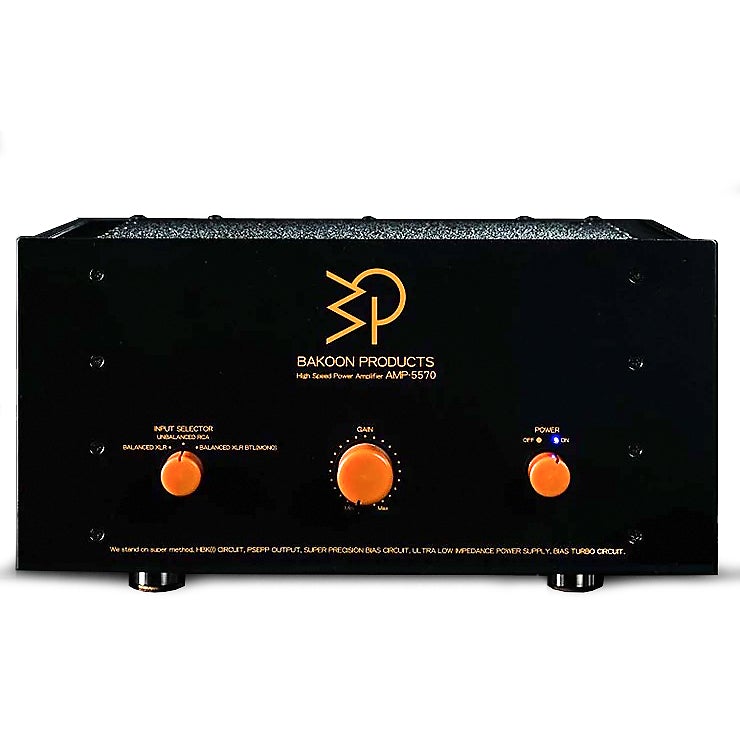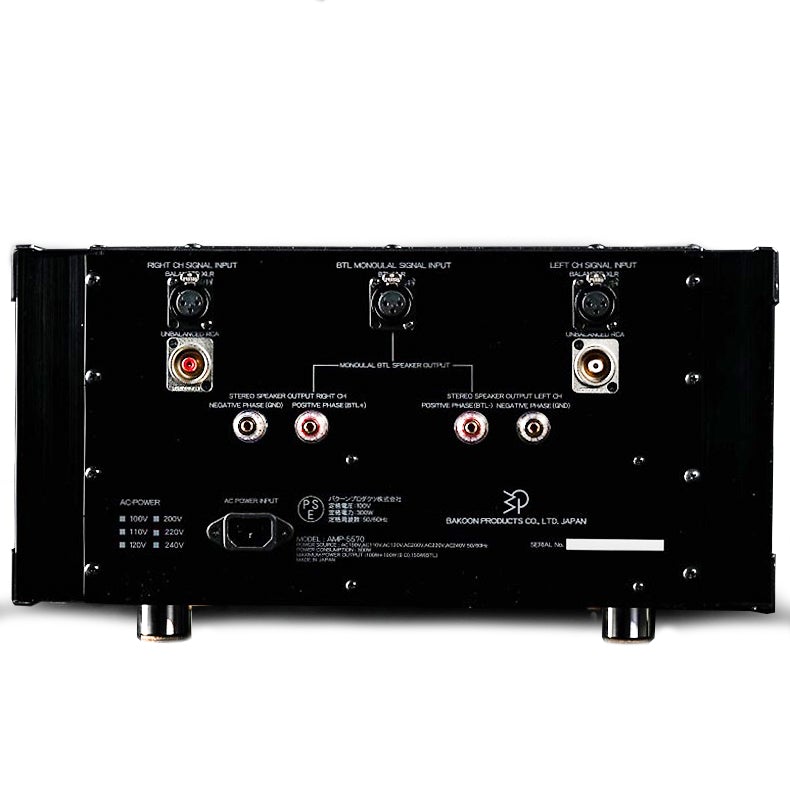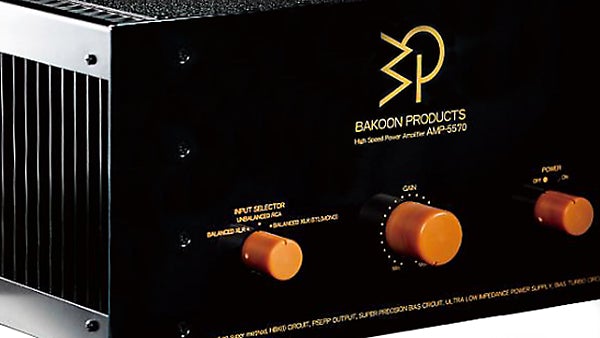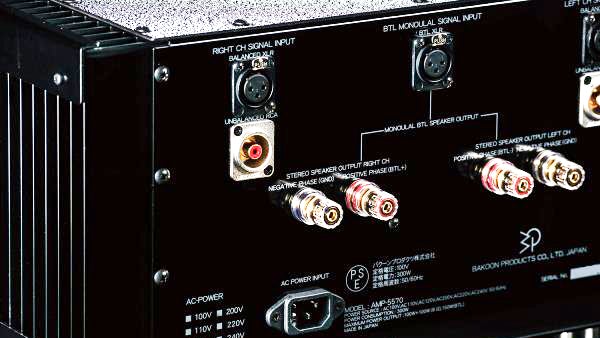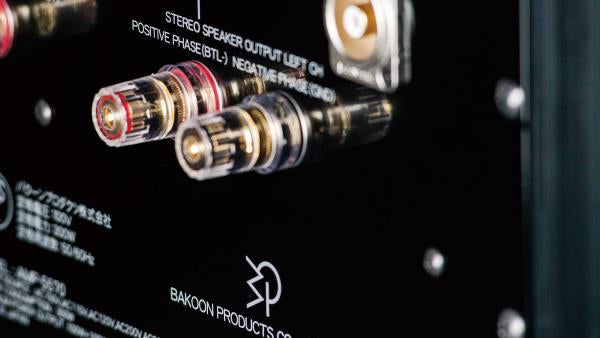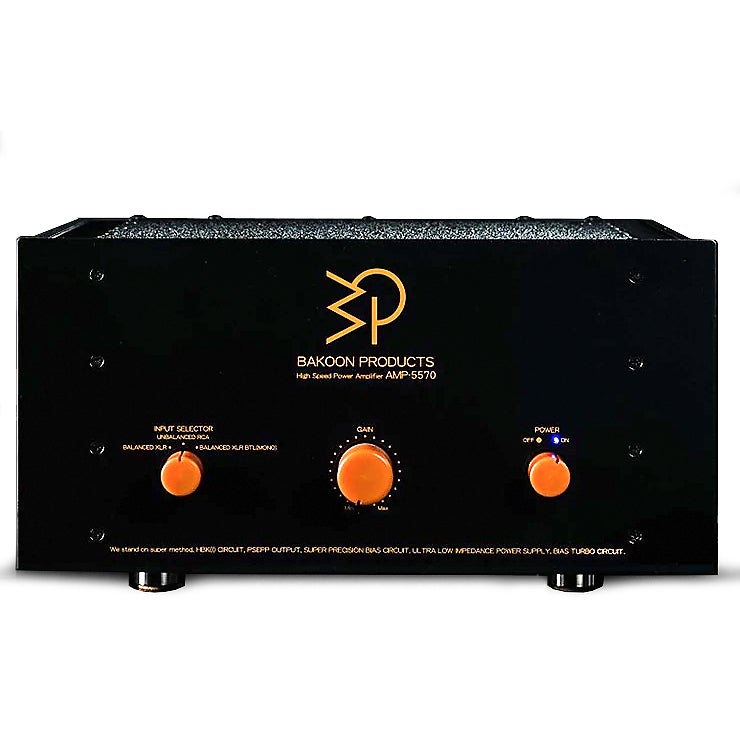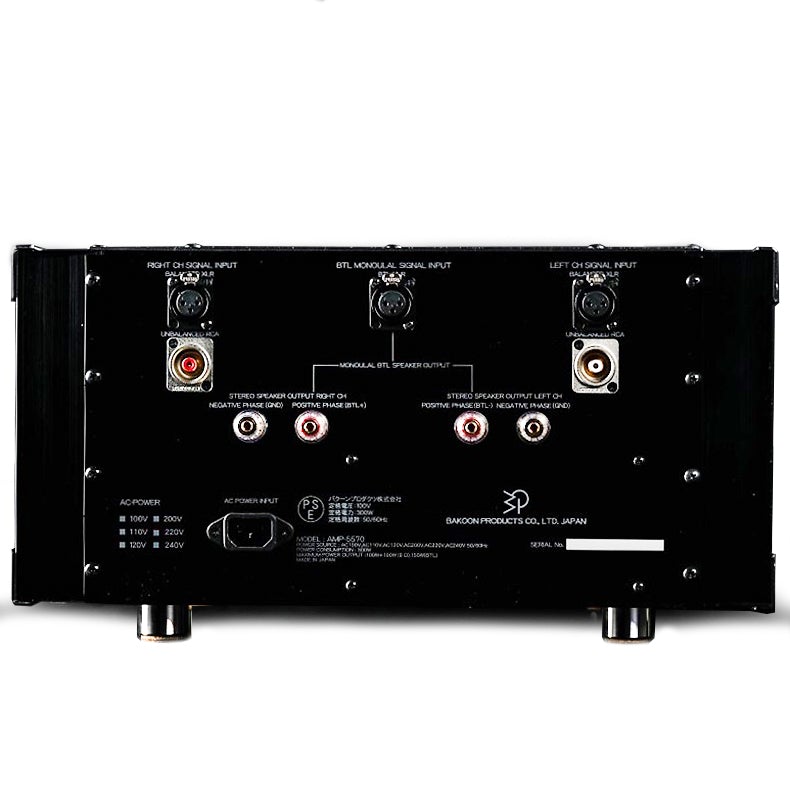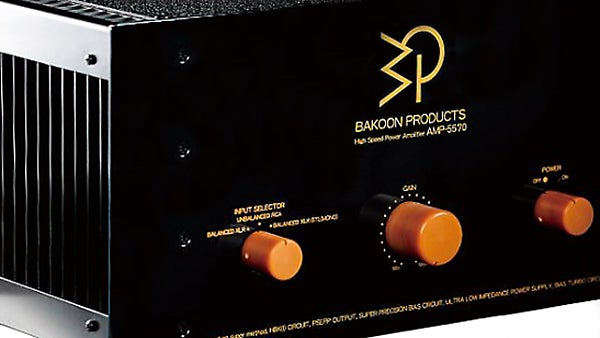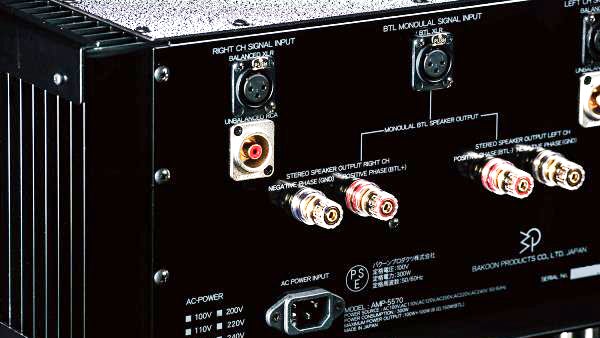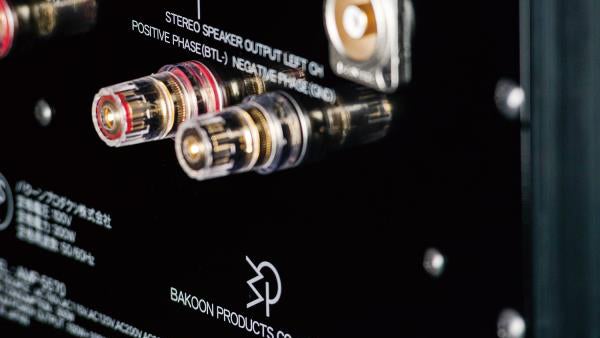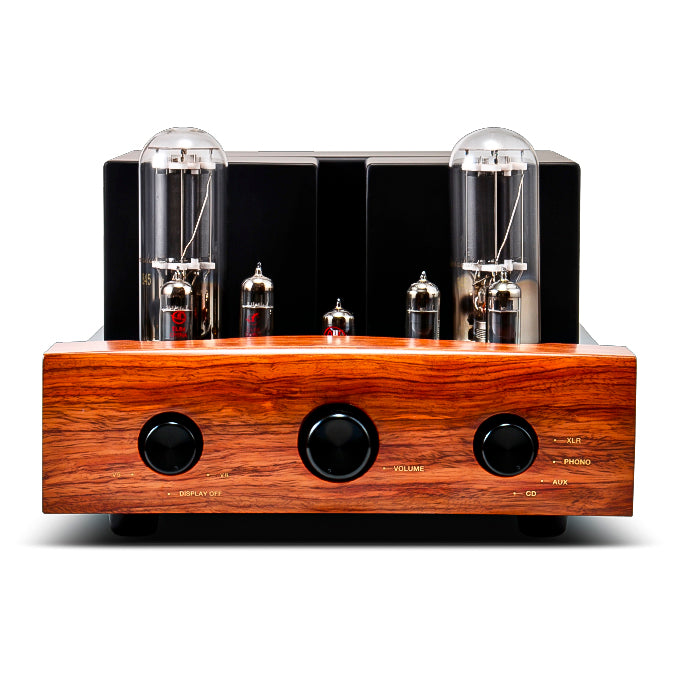Sales will be discontinued as soon as the parts are out of stock at the manufacturer.
Bakoon amplifier with balanced connection
Amplifier for PA to pure audio
Like the AMP5521 and AMP7511A, the AMP-5570 can be converted to a monaural amplifier by connecting two amplifiers together via BTL. By making it mono, the 100W output power becomes even more powerful at 300W. Furthermore, the BTL connection can be easily switched using the input selection dial on the front panel.
The AMP-5570 uses a metal film resistor attenuator as standard, but a higher precision non-inductive wire-wound resistor attenuator can be selected.

Balanced Input
The AMP-5570 does not use an amplification element, but uses a non-feedback non-NFB SATRI circuit that increases amplification with two resistors. instead of using SATRI-LINK, the input has a balanced input, so an OP amp is used for balanced-unbalanced conversion, but if an OP amp is used, The OP amp makes the sound thicker than the pure SATRI-IC circuit. There are three inputs: balanced XLR, unbalanced RCA, and BTL-XLR. With balanced XLR, the signal passes through the OP amplifier, but with unbalanced RCA and BTL-XLR, the signal does not pass through the OP amplifier, making it a pure SATRI circuit.The AMP-5570 is a new-generation amplifier without current connections, featuring balanced inputs using OP amplifiers, which Bakoon products with SATRI-ICs have not had until now, and a taut, thick-wire sound designed for PA applications.
Instead of using XLR, current transmission (SATRI-LINK) was omitted. Although current transmission is obviously technically superior, you will enjoy the integration of amplifiers other than Bakoon Products, and you will also enjoy the sonic changes with various RCA and XLR cables, which were not possible with SATRI-LINK.

| Output | 100W + 100W / 8Ω / distortion 0.8% 300W / 8Ω / BTL mono |
|---|---|
| Inputs | RCA (unbalanced) x1, XLR (balanced) x1, XLR-BTL (balanced mono use) x1 |
| Gain Control | V metal film resistor ATT (standard) / non-inductive wire-wound resistor (optional) |
| Distortion (1KHz) | 0.1% |
| S/N Ratio | 108dB |
| Frequency Response | 10~50kHz |
| Phase response | 0° / 10kHz |
| Size | 230mm(H) x 440mm(W) x 360mm(D) |
| Weight | 18kg |
| Power source | 100V, 120V, 220V, 240V/50,60Hz |

Metal film resistor ATT has a very high information content, very good sound separation, and a rich mid to low frequency range.
The non-inductive wire-wound resistor ATT has minimal distortion, very high resolution, rich low frequency range, and a natural sound without any habit despite its dynamic sound.
The AMP-5570 is, in a word, an amplifier to which new technologies and new methods of circuitry are applied, making comparisons with existing Bakoon products meaningless. Mr. Nagai, the engineer, explains the technical background from various angles. How the circuit is done, voltage and current, negative feedback, etc. .... Is this really important to us? He says it all by sound. .... Still, let's examine it from the outside first, it's a size we haven't seen before in Bakun. It rivals the flagship amplifiers of other companies. It's big enough to shed the stigma of being a lunchbox amp already. I put it on the rack and liked its dependable appearance. How important is the visual imprint of the first impression? The external appearance is passable enough; there is one part of the AMP-5570 that adds to its design perfection. The sharp areas above and below the heat-dissipating pins that release the heat generated by the amplifier are covered with protective plates folded by the actors to protect the user. It is a novel and reassuring idea. The black front panel with a pearlescent feel that drifts in a charismatic style, and the knob made of Bakoon's identity orange Bakelite material approaches with a simple but powerful sensibility.
Let's look at the back. Instead of current transmission (SATRI-LINK), XLR was used for this product. It is probably a choice that tries to reduce uniqueness as much as possible. Thanks to this, high-end users can now choose cables more easily. Instead of BNC cables, which were not a good choice, they can simply connect various RCA and XLR cables that are normally available. This amplifier can be easily changed between STEREO and MONO. After selecting "BALANCED XLR BTL (MONO)" with the input selector on the front panel, simply plug the XLR inter-cable into the "BTL MONOULAL SIGNAL INPUT" on the rear panel. When connecting speaker cables, you should connect them as indicated on the rear panel, but the + side should be connected to the right speaker terminal + side, and the - side should be connected to the left speaker terminal + side.
The Bakoon's rated output, which used to be indicated by 15W, 21W, 35W, 97W, etc., is now a three-digit number: 100W per channel, 100W per channel for those who don't know. 100W per channel; for those who don't know, this number may be meaningless, but the 21W 7511 BTL mono amp is the Bakun that fooled the output of other companies' amps while playing with large speakers. With 100W of Bakoon, we should see that the 600-700W class of other companies' amplifiers can do it. Adding a single AMP-5570 here, plugging in an XLR cable, and turning the selector to BTL mono mode easily makes it a monster-class amp with 300W per channel.
I could feel a hint of heat through the body of the amp. The warmth is as if a living organism is saying, "I'm working properly right now. The author was very pleased with this warmth, which seems to be connected to the quality of the sound. Some of the Bacoon models released in recent years captured the accuracy, speed, and drive, but had a thin sounding "cool and clear" feel. A high-end power amplifier should combine power, speed, and texture, but the sound was on the borderline of having a medium level of texture and hotness. The AMP-5570, however, had the true deep oil painting colors of the early high-end AMP-5513, with added power, speed, and drive. The basic sonic feel is similar to that of a vacuum tube, and it has an excellent ability to make the sound leave the speaker at high speed. The powerful driving force sends the speaker unit to the exact position. No part of the bandwidth is unbalanced by it. The microdynamics are finely adjusted, and the performer's expression of nuance is outstanding. In addition, the secluded background is truly unparalleled. The background is black, like a black hole. Just before the music jumps out, in that jet-black hush, when the weak instrumental sounds begin, it is like seeing a ray of light in the thick darkness.
If one were to carefully evaluate the AMP-5570, it would apparently have a negative impact on the company's other amplifier sales. This is because it came out with a very realistic price tag. For instrumental textural expression, I would say to choose the AMP-5570 over the more expensive low-end MONO amps. When you have less than two sources, if you want to configure an optimal audio system with a single amplifier, it would be very difficult to find anything other than the AMP-5570. In a word, it is sufficient to be directly connected to the sources and used like an in-tear amplifier. Of course, I'm talking about a power amp, not an inti amp, but you could use the Bakoon's unique gain control function with volume. This is possible because even with low gain, the balance of high, mid, and low frequencies is maintained, and there are no restrictions on driving the speakers.
I've been using and watching Bakun Products for a long time, and I have to say that I'm amazed at the progress they've made so far. Quite often, many manufacturers take circuits and mechanisms that have already been developed and put them out as something new, with only the chassis in place. Of course, improving what they already have can be called development, but it is more like tuning than fundamental technological progress. To adapt the chassis to the latest trends and replace parts and materials is to tune a conventionally developed product to suit one's tastes, not to advance technology.
*Audio Monthly (http://www.audioht.co.kr)
Mahler Symphony No. 1, 1st movement, conducted by Michael Tilson Thomas and performed by the San Francisco Philharmonic. The resolution and speed of the Bacoon on current output are first-rate, and the rich musicality is as praiseworthy as ever, but I wondered if it would be possible to exceed this level without SATRI-LINK. The AMP-5570's sound was more informative, with a greater sense of spatiality and reverberation, and each note had more energy and substance. A little fleshier? Or rather, more like the sound of a musical instrument? You can definitely feel the weight. I couldn't help but clap lightly. Next up was Jimmy Smith's "The Preacher," a live recording with a slightly rougher feel that added to the liveliness and charm of the recording. The environment and atmosphere of the time of recording are fully expressed. Of course, the SATRI-LINK amplifiers are excellent, but the AMP-5570 is far more realistic, shall we say? It is more colorful and energetic, and the charm of the music itself moves the listener. In particular, it is rich in spatial expression, and the tension around the stage and the reactions of the audience come to life.
Listening to Hans Zimmer's "Resimental Brothers" from the "Dunkirk" movie OST with ATC SCM20 bookshelf speakers, played only with AMP-5570. The very fine violin treble blooms near center right, showing off its presence. In the center of the stage, the slight sharp textures of the violins double the tension of the piece, "scrambled" by the big, thick wind instruments. The drum beat, which sounds like a heartbeat, is ample and solidly tight. The entire stage is wide and deep. No matter how tall the AMP-5570 is, it is truly amazing that a small bookshelf, not even 60 cm high and not even deep, can portray a vast and deep stage.
100W per channel; those who don't know this number may find it meaningless, but the 21W 7511A BTL mono amp played on big speakers and made a mockery of the output of third-party amps. The 100W from the Bacoon would have to be a 600-700W amp from another company. Just add one AMP-5570, plug in an XLR cable, and switch the selector to BTL mono mode, and you have a simple 300W per channel monster-class amplifier. Gentle heat can be felt through the amplifier's body... I am very happy that this warmth seems to be connected to the sound quality. How about the graininess? Recent Bakoon models released have accuracy, speed, and drive, but with a thin "cool and clear" feel. The new AMP-5570, however, has eliminated that tendency. The basic sound feel is similar to that of a vacuum tube, and its ability to pull sound out of a speaker at high speed without slow corners is outstanding. The powerful driving force allows the speaker units to be positioned precisely. The bandwidth balance is therefore unbalanced. Microdynamics are well adjusted, and the nuances of the performer are excellent. In addition, the quiet background is unparalleled. The background is jet black, like a black hole. The way the instruments begin with a black silence just before the music bursts out is like a line of light coming from the darkness.
*Audio Monthly (http://www.audioht.co.kr)
